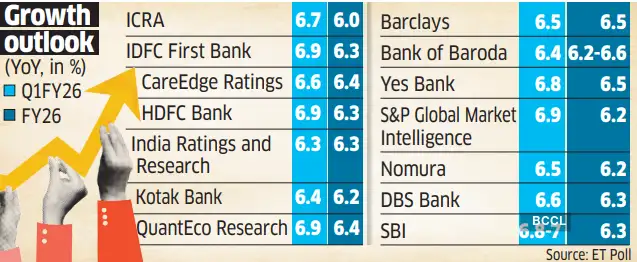The expansion estimates vary from 6.3% to 7%, aligning with the Reserve Financial institution of India projection of 6.5%. India's gross home product (GDP) grew by 6.5% within the first quarter of final fiscal 12 months. The Nationwide Statistics Workplace (NSO) will launch the official GDP figures for the April-June quarter on August 29. The federal government's capital expenditure rose by 52% year-on-year in Q1.

Building & farm sectors key
Aviation cargo visitors, items and providers tax (GST) assortment, and metal manufacturing additionally recorded development.
“GDP development is predicted to be supported by sturdy public spending, bettering rural demand, and a resilient providers sector,” stated Rajani Sinha, chief economist, CareEdge Scores.
“Building and agriculture are two sectors the place we've accounted for greater development,” stated Sakshi Gupta, principal economist at HDFC Financial institution. Exports of products and providers rose by 5.9% within the June quarter. “This was aided by frontloaded demand from economies just like the US,” stated Gupta.
Nonetheless, the tempo of development in Q1 doubtless moderated from 7.4% within the March quarter, hindered by weak point in mining and manufacturing sectors.
“International commerce coverage uncertainties and ongoing geopolitical tensions proceed to weigh on the manufacturing sector, whereas the mining sector feels the brunt of early onset of monsoon,” stated Sinha.
“Indicators resembling energy provide and coal manufacturing contracted in Q1, and air passenger visitors, cement manufacturing, metal consumption, and port cargo visitors had been the important thing laggards,” stated Aastha Gudwani, India chief economist at Barclays.
Industrial exercise, measured by the Index of Industrial Manufacturing (IIP), grew 2% in Q1FY26 in comparison with 5.4% a 12 months earlier, whereas manufacturing output fell to three.4% from 4.2%.
“The GDP development in Q1 could be impacted by the weak industrial sector development (resulting from local weather change-led unseasonal rains) and cautious funding demand owing to geopolitical and commerce tensions,” stated Paras Jasrai, affiliate director, India Scores & Analysis.
“The slowdown in development from the earlier quarter was resulting from a possible slowdown in fastened funding development —as personal sector funding stays muted amid the prevailing international commerce coverage uncertainty — and a muted development in personal consumption,” stated Hanna Luchnikava-Schorsch, head of Asia-Pacific Economics at S&P International Market Intelligence.
GST boot to native demand
Wanting forward, India's GDP for FY26 is estimated to develop by a median of 6.3%, barely under the RBI's projection of 6.5%. The estimates vary from 6% to six.6%.
“Progress can be supported by current rate of interest cuts, robust agricultural exercise boosting rural demand, benign inflationary situations, and a beneficial monsoon,” stated Sinha. Additional, home demand is about to get a lift following the GST rationalisation, stated economists.
The six-member Group of Ministers (GoM) on GST charge rationalisation Thursday accredited the Centre's proposal to get rid of the 12% and 28% slabs, consolidating the GST construction into two charges — 5% and 18%.
This shift from the present four-slab construction is predicted to spur shopper demand within the second half of FY26, probably including 20 foundation factors to annual GDP development, in line with HDFC Financial institution.
International dangers
Nonetheless, dangers from international commerce tensions stay vital. The US has imposed a 50% tariff on Indian imports, together with a 25% penalty for importing oil from Russia.
“We estimate a 30 bps influence of US tariffs on India's development for the complete 12 months, in case the present 25% tariff charges stick (we count on them to be ultimately lowered following commerce discussions with the US),” stated Gudwani.
HDFC Financial institution additionally expects a 20-25 bps danger to GDP development if the 25% tariff persists.
“On the home entrance, subdued revenue development within the formal sector and muted hiring in IT stay considerations for city consumption, whilst rural demand holds regular,” stated Sinha.
The World Financial institution and Worldwide Financial Fund (IMF) pegged India's FY26 development at 6.3% and 6.4%, respectively. As per their estimates, India stays one of many world's fastest-growing economies.
Regardless of these headwinds, analysts imagine India's robust home demand will assist cushion the influence of exterior shocks.
“Total, given the comparatively closed nature of the Indian financial system whereby home demand is the mainstay of development, we don't see this 25% tariff risk impacting GDP development meaningfully,” stated Gudwani.










